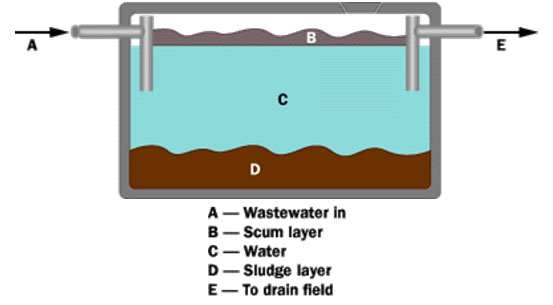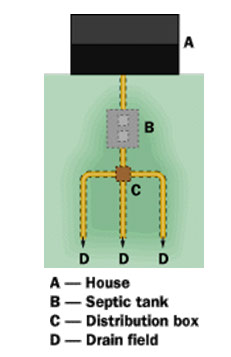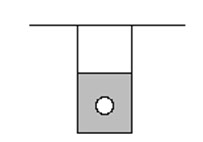Call Us NOW! 920-261-4000
Services
General Services
Other Services
How Septic Systems Work
Private Treatment: The Septic Tank
In rural areas where houses are spaced so far apart that a sewer system would be too expensive to install, people install their own, private sewage treatment plants. These are called septic tanks.
A septic tank is simply a big concrete or steel tank that is buried in the yard. The tank might hold 1,000 gallons (4,000 litres) of water. Wastewater flows into the tank at one end and leaves the tank at the other. The tank looks something like this in cross-section:

In this picture, you can see three layers. Anything that floats rises to the top and forms a layer known as thescum layer. Anything heavier than water sinks to form the sludge layer. In the middle is a fairly clear water layer. This body of water contains bacteria and chemicals like nitrogen and phosphorous that act as fertilizers, but it is largely free of solids.
Wastewater comes into the septic tank from the sewer pipes in the house, as shown here:

A septic tank naturally produces gases (caused by bacteria breaking down the organic material in the wastewater), and these gases don't smell good. Sinks therefore have loops of pipe called P-traps that hold water in the lower loop and block the gases from flowing back into the house. The gases flow up a vent pipe instead -- if you look at the roof of any house, you will see one or more vent pipes poking through.
As new water enters the tank, it displaces the water that's already there. This water flows out of the septic tank and into a drain field. A drain field is made of perforated pipes buried in trenches filled with gravel. The following diagram shows an overhead view of a house, septic tank, distribution box and drain field:

A typical drain field pipe is 4 inches (10 centimeters) in diameter and is buried in a trench that is 4 to 6 feet (about 1.5 m) deep and 2 feet (0.6 m) wide. The gravel fills the bottom 2 to 3 feet of the trench and dirt covers the gravel, like this:

The water is slowly absorbed and filtered by the ground in the drain field. The size of the drain field is determined by how well the ground absorbs water. In places where the ground is hard clay that absorbs water very slowly, the drain field has to be much bigger.
A septic system is normally powered by nothing but gravity. Water flows down from the house to the tank, and down from the tank to the drain field. It is a completely passive system.
You may have heard the expression, "The grass is always greener over the septic tank." Actually, it's the drain field, and the grass really is greener -- it takes advantage of the moisture and nutrients in the drain field.
© 2016 Environmental Specialists All Rights Reserved.
DNR Code Compliance
